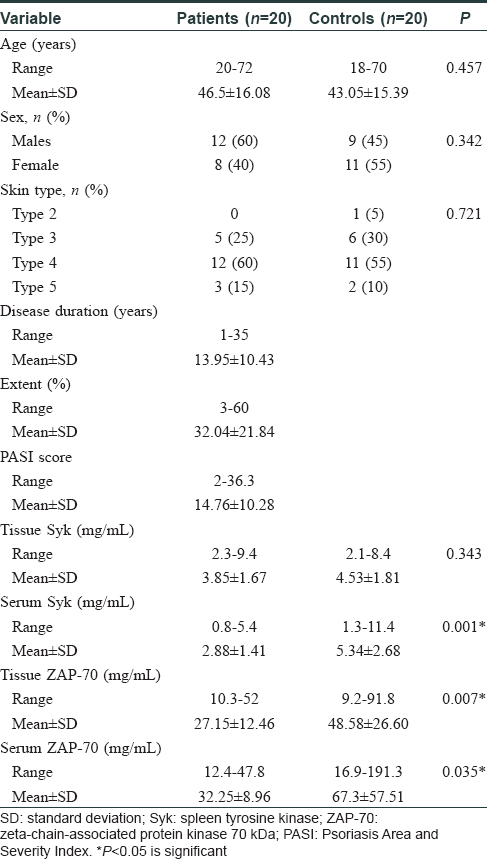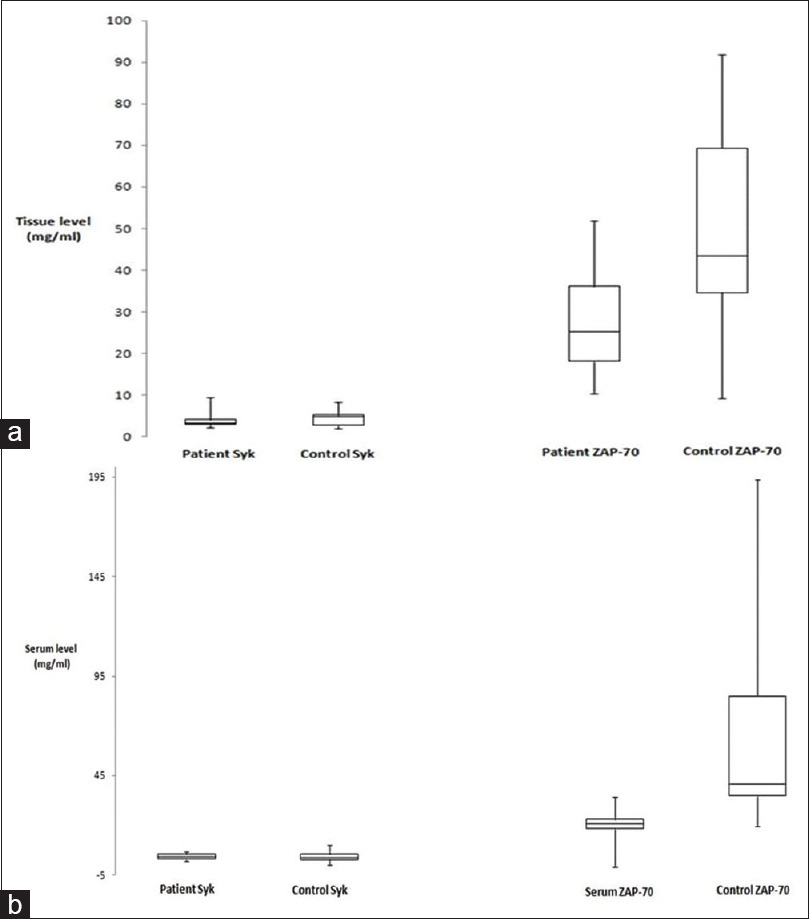Translate this page into:
Assessment of the role of spleen tyrosine kinase and zeta-chain-associated 70-kDa protein (tyrosine) kinase in the pathogenesis of psoriasis
2 Department of Dermatology and Venereology, National Research Centre, Giza, Egypt
3 Department of Chemical Pathology, Faculty of Medicine, Cairo University, Giza, Egypt
Correspondence Address:
Khadiga Sayed Sayed
5th Settlement, New Cairo
Egypt
| How to cite this article: Zaher HA, Gawdat HI, Hegazy RA, Mohammed FN, Alorbani AM, Ibrahim NA, Sayed KS. Assessment of the role of spleen tyrosine kinase and zeta-chain-associated 70-kDa protein (tyrosine) kinase in the pathogenesis of psoriasis. Indian J Dermatol Venereol Leprol 2020;86:85-87 |
Sir,
Spleen tyrosine kinase (Syk) and zeta-chain-associated 70 kDa protein kinase (ZAP-70) belong to the same family of tyrosine kinases (TKs).[1],[2] Syk was proposed to play a role in interleukin (IL)-17 signaling.[1] ZAP-70 is a key regulator of T-cell receptor (TCR) signalling, T-cell proliferation, differentiation and effector functioning.[2] Recent studies are highlighting an etiopathogenic role of these molecules in psoriasis. We studied both the tissue and serum expressions of the phosphorylated (active) forms of Syk and ZAP-70 in psoriasis.
We conducted a cross-sectional study involving 20 new patients with psoriasis (cases) and 20 age and sex matched healthy controls after obtaining approval from the Institutional Ethical Committee. Each patient was subjected to history taking and clinical examination to assess the extent of disease by documenting the Psoriasis Area and Severity Index (PASI) after obtaining their informed consent. The inclusion criteria included absence of any systemic treatment in the last 4 weeks while pregnancy, lactation, concomitant presence of other autoimmune diseases and erythrodermic or pustular psoriasis constituted the exclusion criteria.
We took a 4-mm punch biopsy from scaly psoriatic plaque and normal skin in cases and controls respectively. The control biopsies were taken from redundant skin of abdominoplasty, breast reduction and brachioplasty operations. Three millilitre of venous blood was withdrawn from each participant. The skin biopsies and serum samples were prepared for enzyme-linked immunosorbent assay (ELISA) examination to detect phosphorylated Syk and phosphorylated ZAP-70. [Chongqing Biospes (Chongqing, China)].
The data was analysed to obtain clinio-demographic and biochemical profile of the subjects, which have been tabulated below [Table - 1]. Syk was downregulated in psoriatic skin and serum in comparison to the controls. However, only the serum reduction was statistically significant (P = 0.001). ZAP-70 levels also reduced significantly in both patients' skin (P = 0.007) and serum (P = 0.035) with reference to the the controls [Figure - 1]. There was no statistically significant association between tissue or serum levels of SyK and ZAP-70 with patients' sex, age, duration and extent of disease or PASI score.

 |
| Figure 1: (a) Box plot showing tissue spleen tyrosine kinase levels were lower in patients than controls, but did not reach statistical significance; tissue zeta-chain-associated protein kinase 70-kDa levels were significantly lower in patients than controls. (b) Box plot showing both serum spleen tyrosine kinase and zeta-chain-associated protein kinase 70-kDa levels were significantly lower in patients compared with controls |
Wu et al. (2015) identified SyK as an upstream signaling molecule of IL-17R in human keratinocytes, suggesting it's pro-inflammatory role.[1] In contrast, Hamerman et al. proposed that Syk could have a suppressive role on inflammatory responses.[3] They observed a dramatic increase in the levels of pro-inflammatory cytokines like TNF, IL-6 and IL-12 in Syk-deficient bone marrow–derived macrophages compared with wild-type macrophages, in response to various Toll-like receptor ligands. Taking this into consideration, the downregulation of Syk in our patients with psoriasis might have reduced this postulated suppressive role, thus increasing the secretion of the aforementioned inflammatory cytokines, contributing to the development of the psoriatis.
The contradictory data surrounding the molecule and the disappointing clinical results of fostamatinib (a Syk inhibitor) in rheumatoid arthritis have questioned the role of Syk as a target for immune disorders including psoriasis.[4]
The other member of this family, ZAP-70, has not yet been studied in psoriasis. It was previously reported that single-nucleotide substitutions in the ZAP-70 gene and other molecules in this pathway have been associated with autoimmune diseases such as rheumatoid arthritis.[5] The downregulation of the phosphorylated ZAP-70 in our cases might hint towards it's mutation in psoriasis which may have resulted in it's reduced expression and function. Studying the genetic expression of ZAP-70 in psoriasis might give us a real insight into its specific role in the disease's pathogenesis. This perplexing molecule might also provide a possible therapeutic target for psoriasis by modulating its activity.
The current work gives us insight on the possible role of Syk and ZAP-70 in psoriasis. The unexpected downregulation of Syk suggests a possible dual role and highlights the need for further research to establish its role as a therapeutic target in psoriasis. Moreover, the downregulation of ZAP-70 in our patients may have contributed to theimmune dysregulation. Our limitations include a small sample size and unavailability of polymerase chain reaction to assess protein levels due to financial constraints.
Declaration of patient consent
The authors certify that they have obtained all appropriate patient consent forms. In the form the patients have given their consent for their images and other clinical information to be reported in the journal. The patients understand that their names and initials will not be published and due efforts will be made to conceal their identity, but anonymity cannot be guaranteed.
Financial support and sponsorship
Nil.
Conflicts of interest
There are no conflicts of interest.
| 1. |
Wu NL, Huang DY, Tsou HN, Lin YC, Lin WW. Syk mediates IL-17-induced CCL20 expression by targeting act1-dependent K63-linked ubiquitination of TRAF6. J Invest Dermatol 2015;135:490-8.
[Google Scholar]
|
| 2. |
Ivanova E, Carpino N. Negative regulation of TCR signaling by ubiquitination of zap-70 lys-217. Mol Immunol 2016;73:19-28.
[Google Scholar]
|
| 3. |
Hamerman JA, Tchao NK, Lowell CA, Lanier LL. Enhanced toll-like receptor responses in the absence of signaling adaptor DAP12. Nat Immunol 2005;6:579-86.
[Google Scholar]
|
| 4. |
Nijjar JS, Tindell A, McInnes IB, Siebert S. Inhibition of spleen tyrosine kinase in the treatment of rheumatoid arthritis. Rheumatology (Oxford) 2013;52:1556-62.
[Google Scholar]
|
| 5. |
Begovich AB, Carlton VE, Honigberg LA, Schrodi SJ, Chokkalingam AP, Alexander HC, et al. Amissense single-nucleotide polymorphism in a gene encoding a protein tyrosine phosphatase (PTPN22) is associated with rheumatoid arthritis. Am J Hum Genet 2004;75:330-7.
[Google Scholar]
|
Fulltext Views
3,107
PDF downloads
1,990





